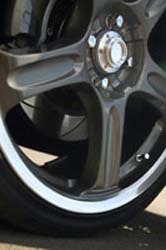 Having flat tires is one common problem encountered by almost every car owner. The major root cause of a flat tire is the under inflation of the tires, which is often a result of gradual loss of tire pressure. In some instances, rapid loss of pressure due to impact or penetration of hard and sharp objects into the tires can be the cause.
Having flat tires is one common problem encountered by almost every car owner. The major root cause of a flat tire is the under inflation of the tires, which is often a result of gradual loss of tire pressure. In some instances, rapid loss of pressure due to impact or penetration of hard and sharp objects into the tires can be the cause.
Following are some tips that will help you with a tire blowout:
- First and foremost, when the tire blows out — remain calm and do not panic.
- Next, make sure that you grip your steering wheel firmly to gain better control of your vehicle.
- Decelerate your vehicle and let it slowly come to a halt, this is done by simply taking off your foot from the gas pedal.
- Make sure you do not force the vehicle into going the direction you want by making any sudden turn of the steering wheel. Go along with the flow a little, slow down, turn on your signal light and work towards getting to the side of the road as swiftly and as safely as possible.
- Brake lightly to bring your car to a complete halt.
- Once your car is stationary, turn on the hazard lights and / or lift up your car boot and hang a white clothe to warn other road users that your car is experiencing a problem.
- If you have the triangular reflective warning sign, place it at a distance (about 50 meters) behind the vehicle. Make sure this is carried out safely.
By following the above steps, you have gotten yourself to a point of safety where you can calmly survey the situation and decide on the best actions to be taken, while making the road safer for other users.
You now have two choices — seek professional help or do the tire change yourself.
- If you have a mobile phone — use it to contact your mechanic or get in touch with one of your friends to help you get the professional help that you need.
- But if you are in a predicament where you must change your own tires (or if you just prefer to do so), here are the guidelines:
- Be very sure that there is more than enough safety distance between your vehicle and the road. If this is not possible — DO NOT PROCEED with the tire change. Stay away from your vehicle and put yourself in a safe place. You will be much better off with the expense of getting a tow truck to tow away your vehicle and replace your flat tire.
- Have a brief check on your spare tire — make sure that it is good enough for use. Make sure that your car is on firm and level ground for safety reasons.
- Take out the car jack and lug wrench from your car boot and read the instructions given on how to lift up your vehicle.
- If your car comes with a wheel cover, remove it with a metal object like a screwdriver or your key to expose the lugs nuts of the wheel.
- Loosen the lug nuts of the wheel before lifting up your vehicle — do the same for all the nuts for the affected wheel. Remember — clockwise direction to tighten and anti-clockwise to loosen.
- Once all the nuts are loosened somewhat, it is time to jack the vehicle up at the recommended location where the jack can be placed to lift up the car; this piece of information is available in the car owner’s instruction manual. Now, totally loosen all the nuts and your wheel is ready to be removed from the car.
- Remove the punctured wheel from your vehicle and replace it with your spare tire, and tighten the nuts — tight enough without having the wheels turning, further tightening will be done after the car jack is being removed.
- Remove the car jack — further tighten the lug nuts using the lug wrench. To ensure that the nuts are properly tightened and maintain the right balance, make sure that you tighten the nuts in a sequential manner, and repeat the process.
- Replace the wheel cap and keep your equipment and the blown tire. You are now done.
Drive slowly to the nearest tire shop and have the tire replaced.
Depending on how well worn your existing tires are, you may choose to replace two tires or all four tires, as it is always a good practice to change tires at the same time for better balance. Make sure you ask your mechanic to check the alignment of the car to ensure that there is no residual effect from the blown tire.
Remember, never compromise safety. Getting into your car with the right mindset and with responsible behavior will serve you well a long, long way.
Wil Yeo is a mechanical engineer by training and maintains the sitewww.avanigroup.com, where you’ll also find a handy guide entitled, Tire Maintenance Guide.
